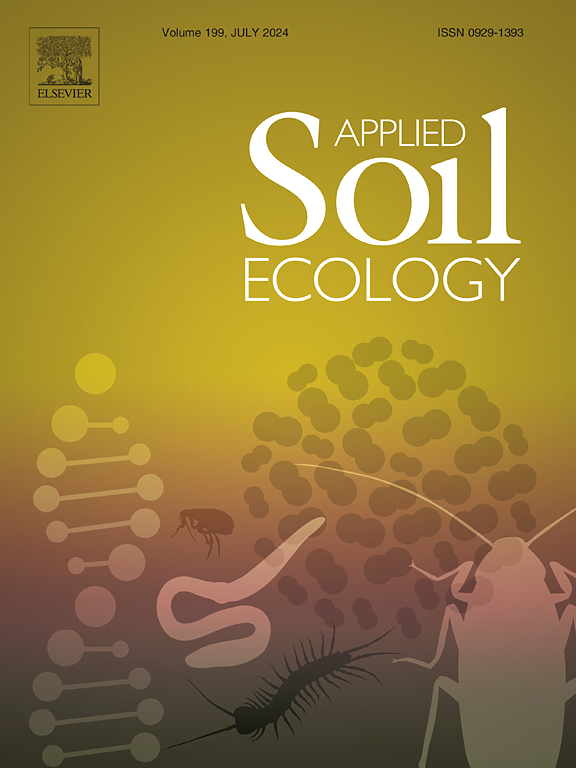丛枝菌根真菌能促进穆乌斯沙漠土壤中的氨同化,但不能促进硝酸盐同化
IF 4.8
2区 农林科学
Q1 SOIL SCIENCE
引用次数: 0
摘要
虽然人们已经确定丛枝菌根真菌(AMF)能同化氮并将其输送给寄主植物,但对 AMF 在土壤氮过程(尤其是无机氮的同化)中的潜在作用还没有进行过全面研究。与其他陆地生态系统相比,沙漠是典型的贫氮环境。生长在荒漠中的大量旱生灌木(如蒿草)与AMF形成了高效的共生关系,在中国的生态恢复中发挥着重要作用。然而,在贫氮土壤中,树胶菌根共生是否有利于其他土壤微生物对氮资源的竞争和对氮同化作用的抑制,还有待进一步研究。为了进一步了解这方面的情况,我们建立了一个旱生植物A. ordosica和AMF的培养系统,并根据旨在阐明AMF在土壤无机氮同化中的作用的对照实验,研究了AMF对土壤硝酸还原酶(NR)和亚硝酸还原酶(NiR)活性、参与氮过程的基因丰度以及土壤微生物组成的影响。我们相应地发现,AMF通过促进土壤NiR活性、上调gltB和gltD基因的丰度以及影响土壤微生物群落,增强了土壤NH4+-N和NO2--N的同化作用。然而,AMF对土壤NR活性有抑制作用,对土壤中NO3--N的同化没有促进作用。虽然与自然条件相比,我们的实验简化了土壤微生物群落的结构,并可能放大了AMF的功能,但在此基础上,我们发现了AMF和A. ordosica共生体新的氮利用机制。具体来说,我们发现真菌伙伴促进了土壤中NH4+-N和NO2--N的同化,但没有促进NO3--N的同化,同时也促进了A. ordosica的生长。这可以降低土壤中的 NO3-N 被其他土壤微生物消耗的可能性。这项研究的结果将有助于加深我们对荒漠植物和AMF在缺氮环境中生存的了解。本文章由计算机程序翻译,如有差异,请以英文原文为准。
Arbuscular mycorrhizal fungi promote soil ammonia but not nitrate assimilation in the Mu Us Desert
Although arbuscular mycorrhizal fungi (AMF) have been established to assimilate nitrogen (N) and transport this to host plants, the potential role of AMF in soil N processes, particularly the assimilation of inorganic N, has not been comprehensively investigated. Compared with other terrestrial ecosystems, deserts are typically nitrogen-poor environments. Numerous species of xerophytic shrubs growing in deserts, such as Artemisia ordosica, form efficient symbiotic relationship with AMF, and play an important role in ecological restoration in China. However, whether arbuscular mycorrhizal symbioses are advantageous with respect to the competition for N resources and inhibition of N assimilation by other soil microbes in nitrogen-poor soils has yet to be established. To gain further insights in this regard, we established a culture system of the xerophyte A. ordosica and AMF, and investigated the effects of AMF on soil nitrate reductase (NR) and nitrite reductase (NiR) activities, the abundance of genes involved in N processes, and soil microbial composition based on controlled experiments designed to elucidate the roles of AMF in soil inorganic N assimilation. We accordingly found that AMF enhanced the assimilation of soil NH4+-N and NO2−-N by promoting soil NiR activity, upregulating the abundance of gltB and gltD genes, and influencing the soil microbial community. However, AMF were found to inhibit soil NR activity and showed no promotive effect with respect the assimilation of NO3−-N in the soil. Although compared with natural conditions, our experiments simplified the structure of the soil microbial community and may have amplified AMF function, on the basis of our findings, we identified a new N-utilization mechanism of AMF and A. ordosica symbionts. Specifically, we found that the fungal partners promote soil NH4+-N and NO2−-N assimilation, but not that of NO3−-N, while also promoting the growth of A. ordosica. This can reduce the likelihood of soil NO3−-N being consumed by other soil microbes. The findings of this study will contribute to enhancing our understanding of the survival of desert plants and AMF in nitrogen-deficient environments.
求助全文
通过发布文献求助,成功后即可免费获取论文全文。
去求助
来源期刊

Applied Soil Ecology
农林科学-土壤科学
CiteScore
9.70
自引率
4.20%
发文量
363
审稿时长
5.3 months
期刊介绍:
Applied Soil Ecology addresses the role of soil organisms and their interactions in relation to: sustainability and productivity, nutrient cycling and other soil processes, the maintenance of soil functions, the impact of human activities on soil ecosystems and bio(techno)logical control of soil-inhabiting pests, diseases and weeds.
 求助内容:
求助内容: 应助结果提醒方式:
应助结果提醒方式:


